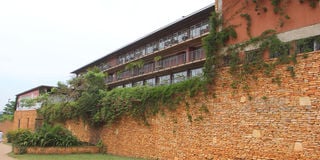Dress up your wall with creeping plants

Creeping plants can be grown in containers attached to the wall, creating a vertical garden and a splash of colour. PHOTO/Ismail Kezaala.
What you need to know:
While a wall covered with leaves is likely to deter the spray can-wielding campaign hooligan, there are far more and better reasons for having a wall covered with greenery
Creepers and climbers are a feature that remains underused locally despite the concept’s advantages. While a wall covered with leaves is likely to deter the spray can-wielding campaign hooligan, there are far more and better reasons for having a wall covered with greenery.
What do you do when you wake up one day to find graffiti or an aspiring politician’s name spray painted on your beautiful perimeter wall in ugly black letters?
You can scrub the wall or wait until the elections are over and repaint it, or you can opt for a less conventional but more permanent way to deal with the problem creeping plants.
Besides creeping plants, there are climbers that can also be used to provide a green cover on a wall. The main difference is that creepers have tendrils and cling on to a wall while climbers usually need a support system, such as a wire. Creepers and climbers are a feature that remains underused locally despite the concept’s advantages. While a wall covered with leaves is likely to deter the spray can-wielding campaign hooligan, there are far more and better reasons for having a wall covered with greenery. The main reason people choose to have creepers and climbers is for the aesthetics to provide a different look from the bare or painted wall.
The plants can also be used to enhance privacy for example, when woven through a chain-link fence and generally freshen the air. For instance if you want to enjoy your garden in peace and quiet without being disturbed by nosy neighbours or passers-by, a fence or a wall is often the only option. Unfortunately, privacy screens are often anything but elegant and tend to clash with the otherwise green garden. Fortunately, nature provides a great solution to this problem in the form of climbing plants. Climbing plants wind their way up walls and fences effortlessly and, while doing so, look enchanting with their colourful flowers and green leaves. Ivy is not the only climbing plant you can use to add greenery to walls and fences.
Pius Mwambingu, a landscape architect with Landtek Studio, says in urban areas, people are opting to maximise on the available land, creating a concrete jungle that has little space for greenery.
“The amount of hard surface is too much. In estates, you can use creepers to soften such a set-up,” he says.
Rough finish
but creepers are not restricted to perimeter walls. They can also be used to adorn part of, or even the whole house. The most common creeping plant is the creeping fig, scientifically known as ficus pumila, while the European Ivy (hedera helix) is more of a vine that does not cling to walls and, therefore, requires support. The success of the wall plants depends on many factors, including where they are planted and the care they are given.
Mwambingu says that in the case of the creeping fig, for example, it should be planted at intervals of about half a metre along the wall.
“Regular watering of the plants is important. One should also add farmyard manure or fertiliser but not very frequently, say once every six months to one year,” he advises.
“The most important thing, however, is to spray them with pesticides. This should be about every month to keep them healthy. The moment they are affected by pests, it spreads through the entire wall,” he offers, adding that if you find a dead section, you should clip it off so that fresh shoots can grow.
With good care and proper spacing, creepers will take about one-and-a-half years to cover a wall.
You can expect some insects, especially when the plants are flowering, but rodents are unlikely to attack them if the surrounding areas are not bushy.
Most of the plants are available at roadside nurseries, and there are more than 20 varieties to choose from.
It is advisable to grow the plants on walls that have a rough finish, especially for the clinging kind. “The problem with plastered walls is that the chemistry of the roots will interfere with the paint and cause it to peel off,” says Mwambingu.
In some parts of the world, designers have moved beyond these basic forms to create what are known as living walls. Living walls (or green walls) are described as vertical gardens on the exterior or interior walls of a building.
Unlike creepers and climbers which grow from the ground spreading to cover the wall, the plants in living walls are grown in multiple containers attached to the wall, creating a bushier vertical garden.
What you need to know:
● With good care and proper spacing, creepers will take about one-and-a-half years to cover a wall.
● You can expect some insects, especially when the plants are flowering, but rodents are unlikely to attack them if the surrounding areas are not bushy.




